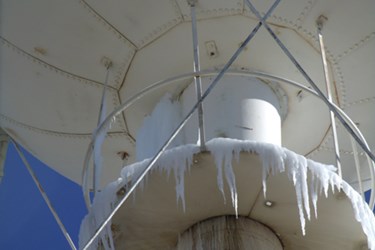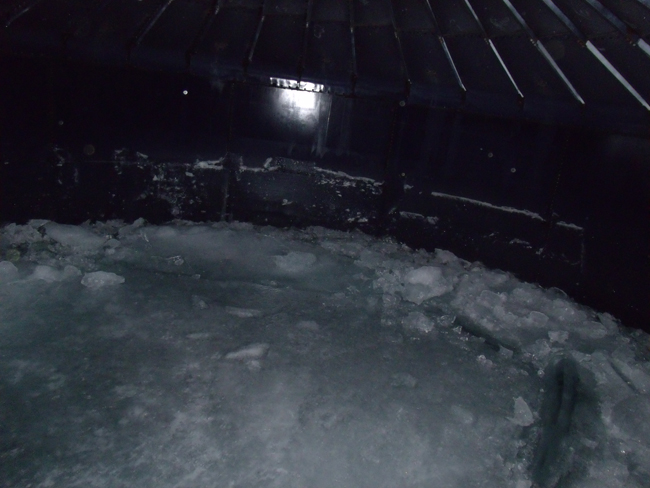Emergency Tank Repair Prevention And Preparation — Avoid Winter Woes

By Erika Henderson, director of research, Pittsburg Tank & Tower, Inc.
Drinking water tanks are surrounded by threats daily, but most problems associated with emergency tank repairs can be prevented. Extra time and maintenance may be needed to ensure the tank is protected, and water operators should have an effective plan to restore water services if a tank emergency does occur.
Most problems that lead to emergency tank repairs can be prevented with proper maintenance and regular inspections. Obtaining accurate information and saving the documentation of every inspection and repair can enable a deeper level of understanding about the tank’s history. The knowledge gained from its history can then be used to help create a more effective strategy in preventing and limiting future tank repairs.
Harsh winter weather often increases the risk for tank damage and emergency repairs. Last winter, several drinking water tanks nationwide experienced damage, leaks, and failures as a result. A Minnesota tank froze twice over the winter because of the prolonged deep freeze.[i] And, according to The Old Farmer’s Almanac’s for 2014-2015, “this winter will be another arctic blast with above-normal snowfall throughout much of the nation.” Therefore, measures should be taken now to protect the tanks and help prevent damage that could be caused by snow, ice, and freezing temperatures.
Drinking water tanks are more susceptible to freeze during nighttime hours when water demand and turnover rate is low. Moving water is less prone to freezing, so keeping the turnover rate high or adding a mixing system can help. The National Fire Protection Association (NFPA) recommends maintaining the water temperature at or above 42° F to prevent tank freezing, and the water temperature can be monitored by installing a low-water temperature alarm.[ii] But, to maintain appropriate temperature, heating may be necessary. Insulation and standby electric heaters can be used for systems not already setup for steam or hot water.
All heater pipes, heating elements, and temperature alarms should be tested, inspected, and replaced as needed before the heating season begins and monthly thereafter or malfunctions are likely to occur. For example, the heater in a wooden Chicago water tank malfunctioned in March and the water inside froze solid. The tank’s structural integrity was compromised and the tank had to be dismantled later that month.[iii]

Bolted tank, frozen over
Changes in temperature can cause pipes to expand and contract making them vulnerable to breaks and leaks. Therefore, all pipes subjected to freezing or temperature change should be protected with insulation and heat tracing. The pipes inside small dry risers of elevated water tanks should also be insulated to prevent the inlet and outlet pipes from freezing. In January, a water pipe broke underneath the foundation of a Minnesota water tower and nearly 500,000 gallons of water was drained from the tank in a mere 30 minutes.[iv]
Pipe connections and expansion joint connections should be monitored closely for leaks. Leaks hidden behind insulation can be difficult to locate, and insulation should be inspected and replaced as needed to reveal any defects hidden behind it and to remain effective. The American Water Works Association (AWWA), NFPA, and Occupational Safety & Health Association (OSHA) have devised a system of codes and standards that contain several recommendations on pipe inspections and a suggested timetable for inspecting each type of pipe.
Pumps, altitude valves, and overflow pipes should be checked before winter to prevent malfunctions. An overflow to grade may freeze solid if screens are plugged or flap valves are stuck, and vents can become clogged with ice and snow if they are not vacuum pressured and frost proof. Pumps or altitude valves that fail to shut off during tank filling can cause the tank to overflow. AWWA states, “A properly operated tank should not overflow during normal operation. An overflowing tank is considered an emergency condition and the malfunction causing the overflow should be determined and corrected as soon as possible.” AWWA does not recommend the use of an internal overflow, because if an overflow failure occurs it could go unnoticed and empty the tank.[v] This past winter, five water distribution pumps in Arkansas froze overnight, leaving the city’s above-ground storage tanks empty. Without water, the city’s fire hydrants became useless and firefighters were left with nothing but the water on their trucks.[vi]
All valves, pipes, controls, alarms, and liquid level indicators must be in proper working order for adequate water to be available. Failure of any component could have dire consequences, and all components may need to be inspected daily during extreme weather for signs of frozen, cracked or damaged areas. Sometimes despite all measures taken emergency repairs may still be needed. Therefore, effective strategies must be devised for a quick response and recovery. An established relationship with a dependable and experienced tank professional, already familiar with the tank, can be extremely useful. The selected full-service tank company should be educated, certified and have received the proper safety training necessary to perform tank inspections, repairs, and modifications. They should be available 365 days a year to answer questions, address concerns, and be flexible enough in their scheduling to make emergency repairs when needed. Please do not attempt to thaw or drain the tank without professional help if water freezing does occur; further damage or a tank rupture could result. Please contact the author or Don Johnston (djohnston@watertank.com; 270-826-9000) for more information on emergency tank repairs.
[i] Hudson, Bill. “Tough Winter Leaves Municipal Water Towers Frozen” Minnesota.cbslocal.com. 14 April 2014.
[ii] National Fire Protection Association. NFPA-22. 2008 Edition. 43.
[iii] Emmanuel, Adeshina and Holliday, Darryl. “Andersonville Water Tower Removed, Frozen Solid” DNAinfo.com. 20 March 2014.
[iv] Hage, Jeff. “Catastrophic break: 500,000 gallons of water emptied from Milaca water tower in a half hour” The Mille Lacs County Time.com. 9 January 2014.
[v] American Water Works Association. AWWA Manual M42. 2013 Edition. 91.
[vi] Suriani, Mike. “Frozen Pumps Leave West Memphis without Running Water” WREG.com. 6 January 2014.
